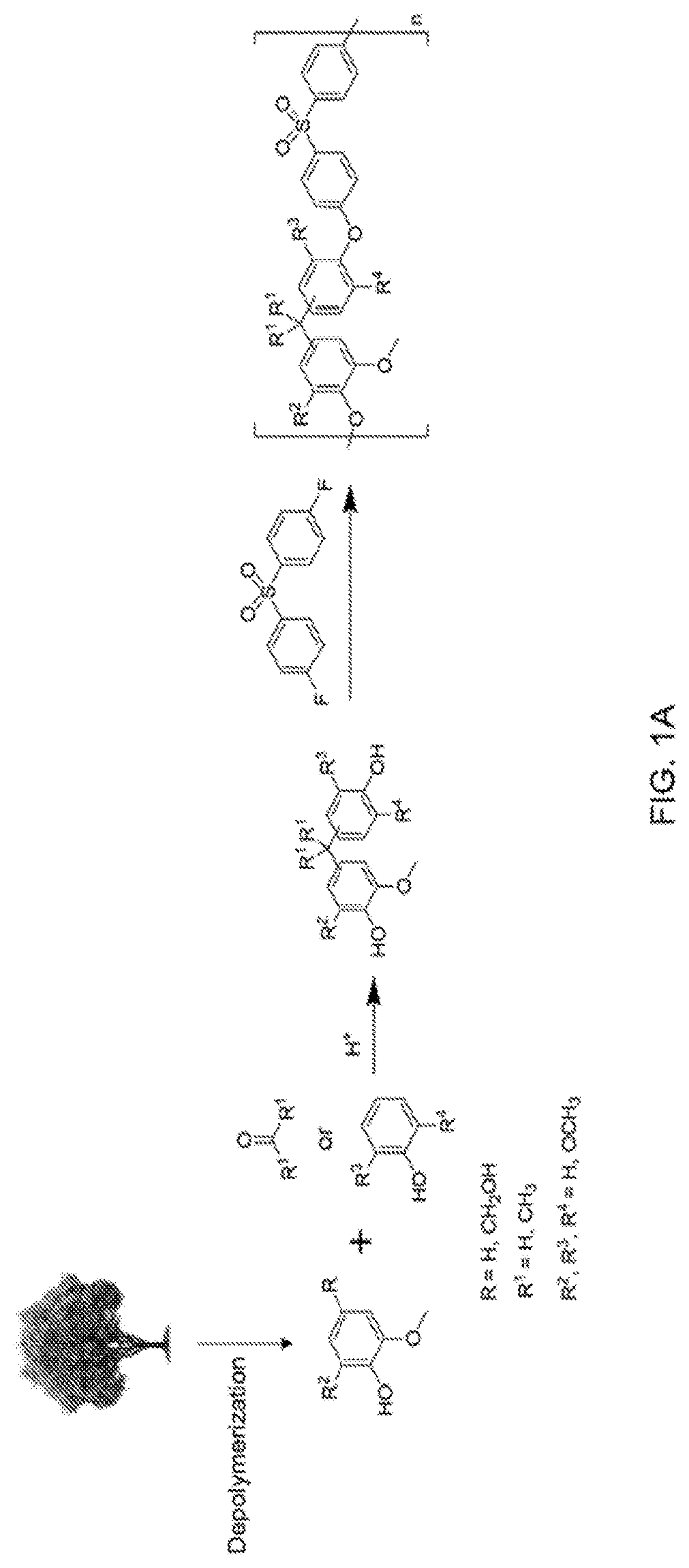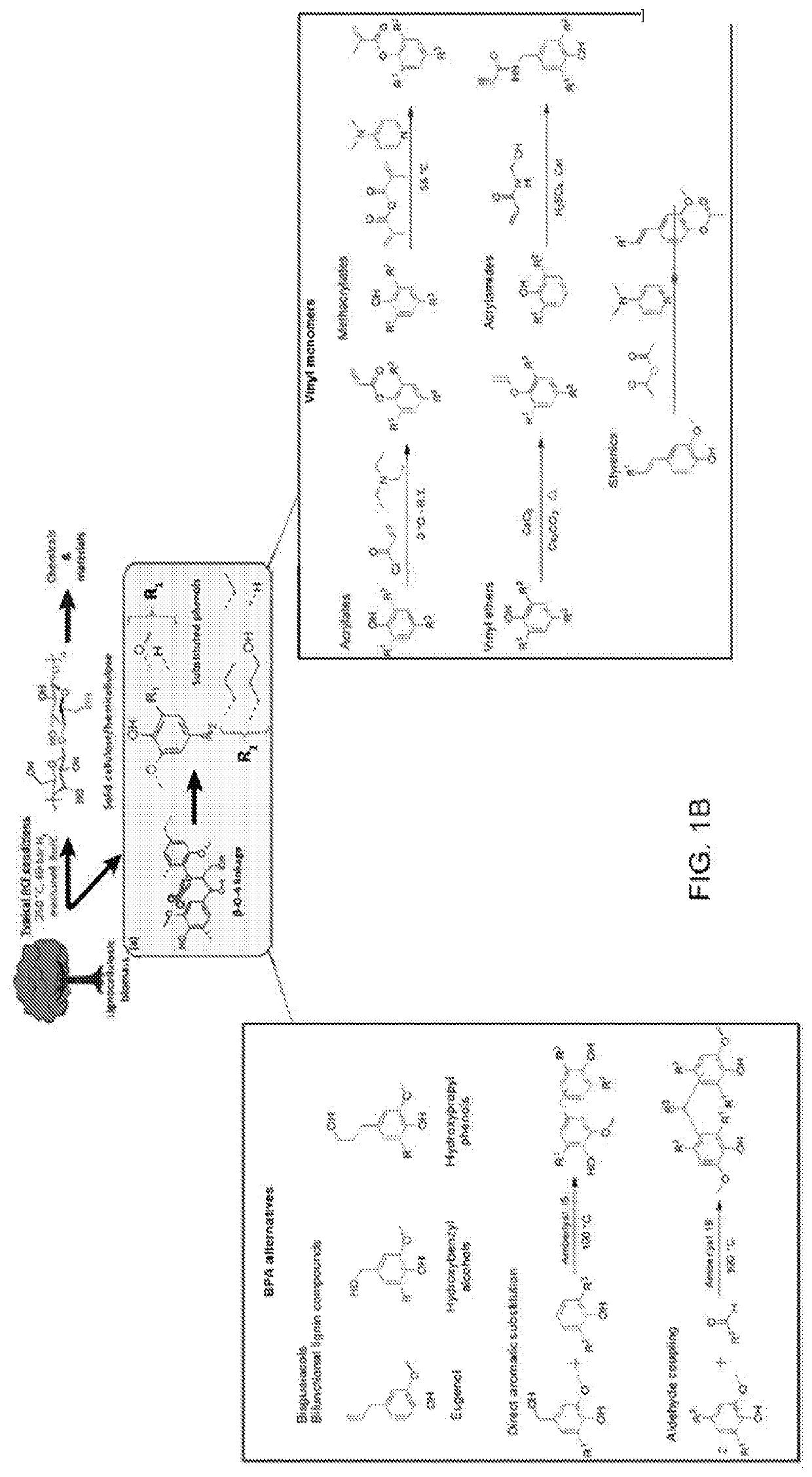Bio-based polysulfones and uses thereof
a technology of bio-based polysulfones and polysulfones, which is applied in the field of bio-based polysulfones or polysulfones, can solve the problems of residual bpa leaching out of the psf membrane into the water, and commercial alternatives to bpa, and achieve the effects of reducing the risk of bpa leaching and improving the stability of the psf membran
- Summary
- Abstract
- Description
- Claims
- Application Information
AI Technical Summary
Benefits of technology
Problems solved by technology
Method used
Image
Examples
example 1
PSf
[0224]BGA (0.50 g, 1.72 mmol), DFDPS (0.47 g, 1.83 mmol), K2CO3 (0.27 g, 1.93 mmol), DMAc (10 mL) and toluene (4 mL) were all added to a two neck 250 mL flask equipped with a condenser, Dean Stark trap, nitrogen inlet / outlet, and a mechanical stirrer. The solution was heated to 135° C. for 2 h under nitrogen to azeotropically distill out the water and toluene. Then, the reaction was continued for 24 h at 135° C. The same experiment was repeated for all polymers synthesized with the same molar ratios. After the reaction, the mixture was cooled, filtered to remove salts, and precipitated by addition to stirring DI water. The isolated polymers were dried under vacuum at room temperature overnight, redissolved in THF and precipitated by addition to stirring DI water two more times. The polymer was dried again under vacuum at room temperature.
[0225]1H NMR spectrum of BGA-based PSf with TMS as an internal standard (CDCl3, 400 MHz, δ) is shown in FIG. 5.
[0226]The thermal properties of t...
example 2
PSf
[0227]A procedure similar to that used in the Example 1 was used except that BGF was used instead of BGA. The thermal properties of the resulting renewable BGF-based PSf and its petroleum-based counterpart are summarized in Table 1. 1H NMR spectrum of BFA-based PSf with TMS as an internal standard (CDCl3, 400 MHz, 6) is shown in FIG. 6.
[0228]FIGS. 7A and 7B displays exemplary SEC traces of BGF-based PSf, BGA-based PSf and BPF-based PSf from the light scattering (LS) detector (FIG. 7A) and the refractive index (RI) detector (FIG. 7B) after the polymerization was carried out for 24 h. The elution curves demonstrate unimodal Gaussian distributions. Dispersity (D) values are calculated to be 1.70, 1.67 and 1.23 for BGF-based PSf, BGA-based PSf and BPF-based PSf polymers, respectively. The dispersity should theoretically reach 2.0 at full conversion, and lower values could indicate unusual polymerization behavior, unique solubility or solution characteristics in THF (used for SEC anal...
example 3
on of Bio-Based PSf Membranes
[0236]The polymers were first dissolved in a high boiling point solvent (N,N-dimethylacetamide) in the amount corresponding to the concentration of 2.5 wt. %. The polymer solution was then passed through a 0.45 μm syringe filter, sonicated in a glass vial inside an ultra-sonic bath for 30 min and left to sit in the glass vial overnight to degas and remove any bubbles that may have formed. The solution was then poured into a Pyrex petri dish and left under vacuum at room temperature overnight. The vacuum oven temperature was then increased to 60° C. for 24 h, and then to 100° C. for 24 h to gradually remove the solvent. To detach the membrane, the petri dish was immersed in a mixture of water and methanol overnight. The membrane was then carefully peeled off and completely dried in the vacuum oven for 24 h.
[0237]FIGS. 10A-10C shows exemplary cross-sectional SEM images of BGF-based PSf membranes. SEM images of the BGF-based PSf membrane cross-sections show...
PUM
| Property | Measurement | Unit |
|---|---|---|
| Length | aaaaa | aaaaa |
| Length | aaaaa | aaaaa |
| Length | aaaaa | aaaaa |
Abstract
Description
Claims
Application Information
 Login to View More
Login to View More - R&D
- Intellectual Property
- Life Sciences
- Materials
- Tech Scout
- Unparalleled Data Quality
- Higher Quality Content
- 60% Fewer Hallucinations
Browse by: Latest US Patents, China's latest patents, Technical Efficacy Thesaurus, Application Domain, Technology Topic, Popular Technical Reports.
© 2025 PatSnap. All rights reserved.Legal|Privacy policy|Modern Slavery Act Transparency Statement|Sitemap|About US| Contact US: help@patsnap.com



